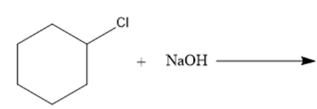
(a)
Interpretation: The nucleophile, leaving group and product formed needs to be identify for the given substitution reaction.

Concept Introduction: In a nucleophilic substitution reaction, the electron rich nucleophile attacks on the electrophilic center of an electrophile (electron deficient) to form nucleophile substituted product. Here, nucleophile can be neutral or have a negative charge. The substitution of nucleophile on the electrophile causes leaving group to leave the electrophile.
(b)
Interpretation: The nucleophile, leaving group and product formed needs to be identify for the given substitution reaction.

Concept Introduction: In a nucleophilic substitution reaction, the electron rich nucleophile attacks on the electrophilic center of an electrophile (electron deficient) to form nucleophile substituted product. Here, nucleophile can be neutral or have a negative charge. The substitution of nucleophile on the electrophile causes leaving group to leave the electrophile.
(c)
Interpretation: The nucleophile, leaving group and product formed needs to be identify for the given substitution reaction.

Concept Introduction: In a nucleophilic substitution reaction, the electron rich nucleophile attacks on the electrophilic center of an electrophile (electron deficient) to form nucleophile substituted product. Here, nucleophile can be neutral or have a negative charge. The substitution of nucleophile on the electrophile causes leaving group to leave the electrophile.
(d)
Interpretation: The nucleophile, leaving group and product formed needs to be identify for the given substitution reaction.

Concept Introduction: In a nucleophilic substitution reaction, the electron rich nucleophile attacks on the electrophilic center of an electrophile (electron deficient) to form nucleophile substituted product. Here, nucleophile can be neutral or have a negative charge. The substitution of nucleophile on the electrophile causes leaving group to leave the electrophile.
Want to see the full answer?
Check out a sample textbook solution
Chapter 7 Solutions
Organic Chemistry (6th Edition)
- Determining the Mechanism of Nucleophilic Substitution Determine the mechanism of nucleophilic substitution for each reaction and draw the products.arrow_forwardComplete these nucleophilic substitution reactions. In each reaction, show all electron pairs on both the nucleophile and the leaving group.arrow_forwardPlease draw the products for each nucleophilic substitution reaction. If there is no product, state why.arrow_forward
- Draw the product of nucleophilic substitution with each neutral nucleophile. When the initial substitution product can lose a proton to form a neutral product, draw the product after proton transfer.arrow_forwardDraw the substitution and elimination products.arrow_forwardComplete the following nucleophilic substitution reactions. In each reaction, show all electron pairs on both the nucleophile and the leaving group.arrow_forward
 Organic Chemistry: A Guided InquiryChemistryISBN:9780618974122Author:Andrei StraumanisPublisher:Cengage Learning
Organic Chemistry: A Guided InquiryChemistryISBN:9780618974122Author:Andrei StraumanisPublisher:Cengage Learning
